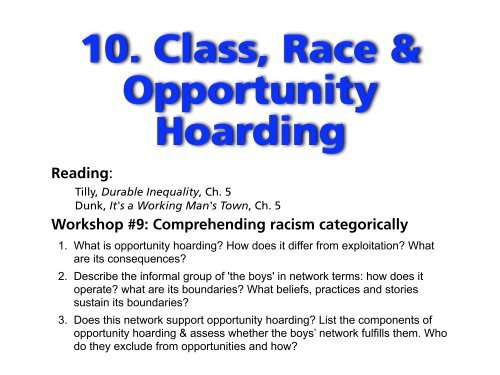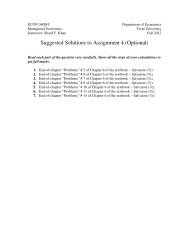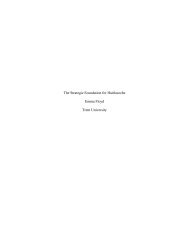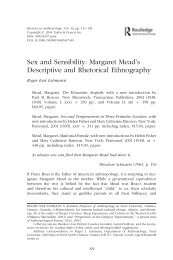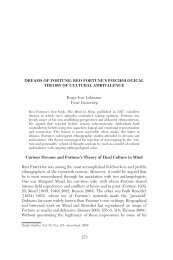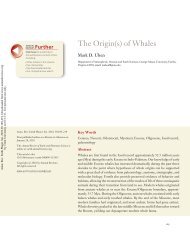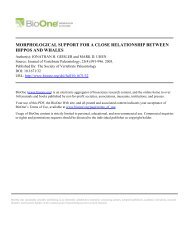10. Class, Race & Opportunity Hoarding
10. Class, Race & Opportunity Hoarding
10. Class, Race & Opportunity Hoarding
You also want an ePaper? Increase the reach of your titles
YUMPU automatically turns print PDFs into web optimized ePapers that Google loves.
<strong>10.</strong> <strong>Class</strong>, <strong>Race</strong> &<br />
<strong>Opportunity</strong><br />
<strong>Hoarding</strong><br />
Reading:<br />
Tilly, Durable Inequality, Ch. 5<br />
Dunk, It's a Working Man's Town, Ch. 5<br />
Workshop #9: Comprehending racism categorically<br />
1. What is opportunity hoarding? How does it differ from exploitation? What<br />
are its consequences?<br />
2. Describe the informal group of 'the boys' in network terms: how does it<br />
operate? what are its boundaries? What beliefs, practices and stories<br />
sustain its boundaries?<br />
3. Does this network support opportunity hoarding? List the components of<br />
opportunity hoarding & assess whether the boys’ network fulfills them. Who<br />
do they exclude from opportunities and how?
Soci 220 2009-10 Week 10 —<br />
<strong>Opportunity</strong> hoarding<br />
I. <strong>Opportunity</strong> hoarding defined<br />
“When members of a categorically bounded network<br />
acquire access to a resource that is valuable, renewable,<br />
subject to monopoly, supportive of network activities,<br />
& enhanced by the network’s modus operandi, network<br />
members regularly hoard their access to the resource,<br />
creating beliefs & practices that sustain their<br />
control” (Tilly, 91)<br />
II. Relation to exploitation<br />
• a secondary mechanism of durable inequality<br />
• complements exploitation<br />
• done mainly by members of non-elite (i.e. those who are not<br />
exploiters, not powerholders, not owners)<br />
• benefits accrue to members of categorically bounded network<br />
that practices opp. hoarding (conversely, losses to members who<br />
leave the category)<br />
• differences:<br />
• exploitation enlists efforts of others<br />
• opportunity hoarding excludes others<br />
2
Soci 220 2009-10 Week 10 —<br />
Elements of <strong>Opportunity</strong> hoarding<br />
I. categorically bounded network<br />
a. categories<br />
b. boundaries:<br />
i. lumping, splitting & defining<br />
c. network<br />
i. its activities & routines<br />
II. access to a resource<br />
a. valuable<br />
b. renewable<br />
c. subject to monopoly<br />
3
Soci 220 2009-10 Week 10 —<br />
Elements of <strong>Opportunity</strong> hoarding<br />
III. beliefs & practices that sustain their control<br />
a. beliefs<br />
• stories that remind members of affiliation<br />
• negative attributions to other side of boundary<br />
• providing reasons for exclusion<br />
b. practices<br />
• that monitor conduct of members & sanction deviance<br />
• rituals that mark belonging & create emotional bonds<br />
4
Soci 220 2009-10 Week 10 —<br />
Examples of opportunity hoarding<br />
I. Italians in New Jersey vs. Lyon (Tilly, ch. 5)<br />
II. ‘The boys’<br />
III. Professions & occupations<br />
IV. Settler Colonies - nationalism from above<br />
V. Politically mobilized excluded ‘minorities’ -<br />
nationalism from below<br />
5
Soci 220 2009-10 Week 10 —<br />
Analysing opportunity hoarding<br />
II. ‘The boys’ (fill in the information yourself for workshop)<br />
a. categorically bounded network<br />
i. categorical pairs —<br />
•<br />
from whom do the boys try to distinguish themselves?<br />
ii. network: transactions & social relations, and their limits<br />
•<br />
who do they interact with? who don’t they interact with?<br />
iii. boundaries<br />
• how do they mark the boundary between themselves & others?<br />
b. to what extent do they have access to resources that are<br />
i. valuable<br />
ii. renewable<br />
iii. subject to monopoly<br />
iv. supportive of network activities<br />
v. enhanced by the network’s modus operandi<br />
c. what are the beliefs & practices that sustain their control?<br />
i. beliefs: stories, negative attributions, reasons<br />
ii. practices: monitoring, rituals<br />
6
Soci 220 2009-10 Week 10 —<br />
Two approaches to racism<br />
I. Dunk: cultural symbols<br />
a. “The ‘Indian’ is employed as a symbol through which<br />
the Boys establish their own moral worth and their<br />
difference from the perceived dominant power bloc.<br />
They ‘imagine’ their own community in opposition to<br />
others, and racial and ethnic characteristics provide<br />
easily discernible markers upon which such divisions<br />
can be constituted.” (Dunk, 102)<br />
b. “The Indian is perceived as an inferior other against<br />
whom white define themselves. The Indian is also a<br />
powerful symbol in the whites’ understanding of<br />
their relationship to other whites, especially those in<br />
the metropolis located in the southern part of the<br />
province.” (Dunk, 102-3)<br />
7
Soci 220 2009-10 Week 10 —<br />
Two approaches to racism<br />
II. Dunk: ethnic categories<br />
c. ethnic divisions within the European working-class of<br />
Fort William / Port Arthur were important at one<br />
time, with some evidence of concentrations of ethnic<br />
groups in particular industries.<br />
i. “The elevators had been a Scottish preserve in the<br />
early years of their existence” (p. 106).<br />
d. but they became practically insignificant by the<br />
1970s:<br />
i. although stereotypes remain, ethnicity plays no role in<br />
qualifying or disqualifying for membership in the Boys, or in<br />
their choice of female companions; it has little significance for<br />
employment, class or social status (p. 107)<br />
8
Soci 220 2009-10 Week 10 —<br />
Two approaches to racism<br />
III. Dunk: racial categories<br />
e. “… when discussions of Indians arose … Physical<br />
markers, such as relatively dark skin, straight black<br />
hair, high cheekbones and so on become significant<br />
in relation to a cultural, social, and economic<br />
context” (102)<br />
i. ethnic categories: based on perceived cultural differences<br />
ii. racial categories: based on perceived physical differences<br />
f. Where does racial categorization come from?<br />
i. The Boys’ “racism is rooted in the immediate experiences of<br />
their everyday lives and in the prejudices and practices which<br />
are widely present in the culture of the Anglo-Saxon<br />
world” (107)<br />
9
Soci 220 2009-10 Week 10 —<br />
Two approaches to racism<br />
IV. Dunk: from racial categories to racism<br />
g. Negative attribution<br />
i. For the Boys “the Indian stands for negative personality<br />
traits” (107): Indians are lawless (110), don’t respect possessions<br />
(111), are hostile to whites (112), their culture is unsustainable<br />
because the land can no longer support it (112), they have<br />
special privileges (‘we give them too much’ — 113).<br />
h. Boundaries on social relations<br />
i. they avoid places where Indians hang out such as ‘Indian<br />
bars’ (108), and they avoid Indian women (109)<br />
10
Soci 220 2009-10 Week 10 —<br />
Two approaches to racism<br />
V. Dunk: deeper into culture<br />
i. images of Indians in the boys discourse:<br />
• noble savage<br />
• backward simpleton<br />
• victim of outside forces<br />
• degenerate, uncivilized, immoral<br />
• welfare bum<br />
• Indian women: sexually ‘easy’, victims of Indian men (p.<br />
113-115)<br />
j. deep cultural roots<br />
i. images of the other in European ideas of “the wild man and<br />
woman” (122)<br />
ii. alternating images of the noble or the depraved savage (123-4)<br />
11
Soci 220 2009-10 Week 10 —<br />
Two approaches to racism<br />
VI. Dunk: from culture to social relations<br />
a. “The Indian is not only an image against which local<br />
whites define themselves. It is also an important<br />
symbol in their understanding of the hinterland/<br />
metropolis relationship between the region and the<br />
centre of political and economic power in the<br />
South” (115)<br />
b. The Boys feel exploited by the South (118-9), and in<br />
competition with Indians for the benefits of the<br />
welfare state (who pays and who receives) (122).<br />
12
Soci 220 2009-10 Week 10 —<br />
Two approaches to racism<br />
VII. From Dunk to Tilly<br />
‘the Boys’<br />
northern white<br />
working class<br />
‘the South’<br />
political &<br />
economic elite<br />
exploitation opportunity hoarding<br />
opportunity hoarding<br />
boundary<br />
‘Indians’<br />
northern<br />
First Nations<br />
& Métis<br />
13
Soci 220 2009-10 Week 10 —<br />
Two approaches to racism<br />
VIII. Tilly: opportunity hoarding by colonial state<br />
(settler colonialism):<br />
a. excluding natives from land - treaties<br />
b. legal definition of categories<br />
c. definition of ‘Indian’ in Indian Act of 1876<br />
14
Soci 220 2009-10 Week 10 —<br />
Two approaches to racism<br />
IX. Tilly: From opportunity hoarding to exploitation<br />
to opportunity hoarding<br />
a. state’s opportunity hoarding sets stage for<br />
exploitation<br />
i. “powerful, connected people command resources from which<br />
they draw … returns by coordinating the efforts of outsiders<br />
whom they exclude from the full value added by that<br />
effort” (Tilly, 10)<br />
ii. metropolitan - hinterland relation in which resources are<br />
extracted from the hinterland<br />
iii. working-class whites like the Boys benefit from settler colonial<br />
opportunity hoarding, but are exploited, & relatively powerless<br />
compared to the political and economic elite<br />
b. the Boys engage, wittingly or unwittingly, in informal<br />
opportunity hoarding “… a process of informal<br />
exclusion which insures that Natives do not learn of<br />
opportunities in areas such as employment …” (p. 120)<br />
15
Soci 220 2009-10 Week 10 —<br />
Two approaches to racism<br />
X. Tilly: opportunity hoarding in response to<br />
opportunity hoarding<br />
a. treaty rights & aboriginal rights as renewable<br />
resources<br />
b. nationalism ‘from below’: opportunity hoarding to<br />
preserve<br />
i. benefits: welfare benefits, health care, housing, access to jobs,<br />
resource royalties<br />
ii. power to determine their distribution, including who is eligible<br />
to receive them — categorical boundaries<br />
• e.g. Bill C-61<br />
16
Soci 220 2009-10 Week 10 —<br />
Two approaches to racism<br />
XI. Conclusions<br />
a. Two forms of opportunity hoarding?<br />
i. by organizations: “a well-bounded set of ties in which at least<br />
one site has the right to establish ties across the boundary…”<br />
ii. by informal networks: triads + categorical pairs<br />
b. Critique of Dunk, Ch. 5<br />
i. Dunk starts to put the Boys racism in a relational context, but<br />
keeps sliding into its cultural roots instead<br />
c. Tilly’s approach<br />
i. social structure of durable inequality: opportunity hoarding &<br />
exploitation,<br />
ii. culture as a repertoire of stories and beliefs that justify<br />
categorical inequalities of class and ‘race’<br />
17
Soci 220 2009-10 Week 9 —<br />
Next week — December 3<br />
11. <strong>Class</strong>, Knowledge & <strong>Opportunity</strong> <strong>Hoarding</strong><br />
Reading:<br />
Dunk, It's a Working Man's Town, Ch. 6<br />
Workshop #11:<br />
Categorical inequalities, education and occupation<br />
Questions:<br />
1. Why are 'the boys' so anti-intellectual? Why is common sense<br />
highly valued?<br />
2. Can the stories the boys tell about intellectuals and<br />
professionals best be understood in terms of exploitation,<br />
opportunity hoarding or adaptation?<br />
3. Do their stories contribute to creating categorical boundaries<br />
or to solidarity?<br />
18


